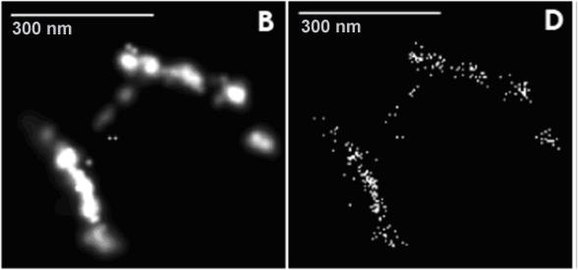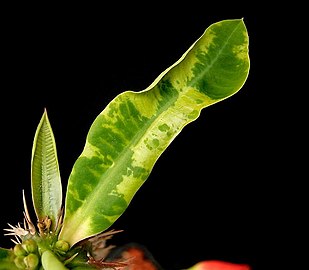Tobacco Mosaic Virus
| Tobacco Mosaic Virus | ||||||||||||||||||
|---|---|---|---|---|---|---|---|---|---|---|---|---|---|---|---|---|---|---|

Tobacco Mosaic Virus |
||||||||||||||||||
| Systematics | ||||||||||||||||||
|
||||||||||||||||||
| Taxonomic characteristics | ||||||||||||||||||
|
||||||||||||||||||
| Scientific name | ||||||||||||||||||
| Tobacco mosaic virus | ||||||||||||||||||
| Short name | ||||||||||||||||||
| TMV | ||||||||||||||||||
| Left | ||||||||||||||||||
|
The tobacco mosaic virus (engl. Tobacco mosaic virus , acronym TMV ) is a 300 nm long and 18 nm thick tubular virus selected from single stranded RNA of about 6400 bases identical and from about 2100 envelope proteins exist. It only infects plants, including tobacco , but also peppers and tomatoes . The TMV gained historical importance because it was the first time that it was possible to detect disease transmission without the involvement of bacteria .
history
The oldest sources are the German Adolf Mayer (1882) in the Netherlands and Dimitri Iwanowski (1892) in Russia . Mayer and Iwanowski demonstrated that the mosaic disease of tobacco plants can be transmitted to healthy plants by means of a bacteria-free extract from diseased tobacco leaves (horizontal transmission). Six years later, the finding was confirmed by the Dutchman Martinus Willem Beijerinck .
The virus was isolated and crystallized for the first time in 1935. In 1936 , a team led by John Desmond Bernal found liquid-crystalline states in its aqueous solutions , in which the rod-shaped viruses are largely parallel. The discovery of the protein double disk of the TMV as well as the further structure elucidation of such nucleic acid-protein complexes by Aaron Klug with the further developed crystallographic electron microscopy was honored by the Nobel Prize in 1982 . In the 1950s , Heinz Fraenkel-Conrat showed that the virus nucleic acid (RNA) and not the envelope protein carries the genetic information, and in 1960 he and his work group succeeded in completely sequencing the 158 amino acid TMV envelope protein , which was the largest protein at the time whose sequence was known.
Hosts and diffusion
The tobacco mosaic virus causes the economically important mosaic disease of tobacco. However, it also infects a large number of agricultural crops and ornamental plants from more than 9 plant families. It is transmitted very easily, e.g. B. through direct contact between plants, through plant sap, in some plants through seeds and above all through agricultural culture practices in the handling of infected plants. In contrast to many other plant viruses, it is extremely heat-stable. Because of these properties, it is probably one of the most widespread viruses worldwide and it is no coincidence that it was the first virus to be described.
Chlorosis in Euphorbia viguieri due to the TMV
Virus formation through self-assembly
TMV became known among other things for its ability to self-assemble . If the RNA of the virus is mixed with its proteins, a complete virus is also formed in the test tube ("in vitro"). Interestingly, the coat protein is also able to assemble into a virus-like particle without the RNA. The agglomeration of the protein subunits depends essentially on the pH value of the solution and its ionic strength (salt concentration).
Use as a biotransistor
In current research, the tobacco mosaic virus is used as a tool for novel electronic components in nanotechnology for the development of a field effect transistor. A semi-conductor layer is created on the tobacco mosaic virus through a biomineralization process .
Web links
- Prof. Weg, University of Stuttgart, Department of Molecular Biology and Virology of Plants
- University of Idaho: Plant Viruses Online (in the WebArchive)
- Descriptions of Plant Viruses (English)
Individual evidence
- ↑ ICTV Master Species List 2018b v1 MSL # 34, Feb. 2019
- ↑ a b c d ICTV: ICTV Master Species List 2019.v1 , New MSL including all taxa updates since the 2018b release, March 2020 (MSL # 35)
- ↑ SIB: Tobamovirus , on: ViralZone
- ↑ Butler, JP, Klug, A .: How does a virus form? Spectrum of Science, January 1979, pp. 4-14
- ↑ Atanasova, P., Rothenstein, D., Schneider, JJ, Hoffmann, RC, Dilfer, S., Eiben, S., Weg, C., Jeske, H. & Bill, J. (2011): Virus-templated synthesis of ZnO nanostructures and formation of field-effect transistors , Adv. Mat., 23, pp. 4918-4922.
- ↑ Andrea Mayer-Grenu: The world's first field-effect transistor based on viruses. University of Stuttgart, press release of July 10, 2012 from the Science Information Service (idw-online.de), accessed on September 15, 2015.
literature
- Iwanowski, D. (1892): Izv. imp. Akad. Nauk. 35, 67.
- Mayer, A. (1886): About the mosaic disease of tobacco. The agricultural test stations 32, pp. 451-467.
- Bawden, FC, Pirie, NW, Bernal , JD, Fankuchen, I. (1936): Liquid Crystalline Substances from Virus-infected Plants . Nature 138, pp. 1051f. With detailed commentary in: Crystals that Flow. Classic papers from the history of liqid crystals. Compiled with translation and commentary by TJ Sluckin et al .; Taylor & Francis, London and New York 2004. ISBN 0-415-25789-1
- Klug , A. (1983): From Macromolecules to Biological Molecules. (Nobel Lecture Stockholm 1982.) Angewandte Chemie 95, pp. 579-596.


